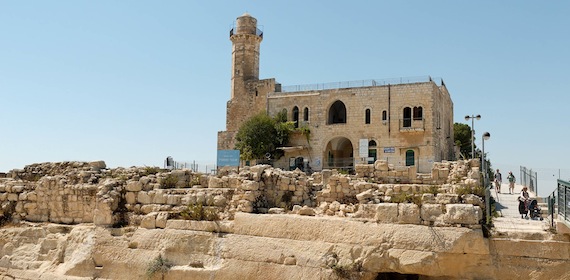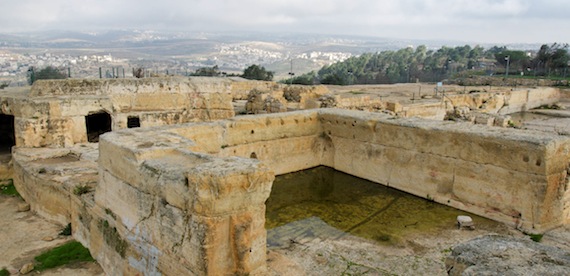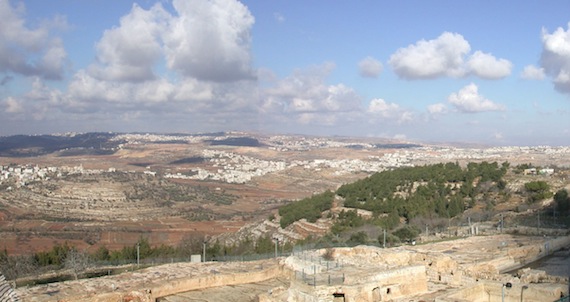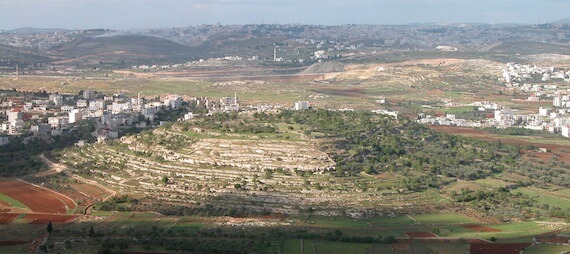Most travelers to Jerusalem never think to come to Nebi Samwil. The minaret towering above the hill looks like a misplaced lighthouse searching for the sea. On a clear day, a visitor can spy the Mediterranean to the west.

(Photo: Nebi Samwil. Courtesy of the Pictorial Library of Bible Lands)
Although few come here today, there were few more important places in David’s and Solomon’s time—if any. In fact, it signified Solomon’s most defining moment.
What’s more, it represents the potential for ours as well.
Nebi Samwil—An Odd Name for a Key Site
For archaeologists, the Hasmonean, Byzantine, and Mamluk ruins surrounding the hill of Nebi Samwil no doubt offer a reason to come. But a climb up the staircase of the century-old structure allows you to drink in the panoramic view from its open-air rooftop.
Nebi Samwil means the “Prophet Samuel,” referring to his burial place—which it isn’t. Someone in the 6th-century tagged the hill as Ramah, the burial place of Israel’s greatest and final judge (1 Samuel 25:1). As a result, Justinian built a monastery here in Samuel’s honor—and the misnomer has stuck ever since. (Similar contradictions have attached to David’s Tomb, Rachel’s Tomb, and Joseph’s Tomb.)

(Photo: Excavations at Nebi Samwil. Courtesy of the Pictorial Library of Bible Lands)
Nebi Samwil offers an unsurpassed view of the Central Benjamin Plateau—a wide tableland that spreads north of the hill country of Judea.
- In antiquity, the terrain above and below this plateau funneled travelers, traders, and warriors across it.
- Coming from the east or west, the area remained the primary access to Jerusalem.
No wonder an estimated half of all narratives in the Hebrew Scriptures occurred here! Everyone associated with Jerusalem wanted to control it.

(Photo: The Central Benjamin Plateau from Nebi Samwil. Courtesy of the Pictorial Library of Bible Lands)
Standing atop Nebi Samwil, history stretches in every direction:
- The Mountains of Ephraim to the north and the towers that landmark Baal-hazor (2 Samuel 13:23).
- To the east, a dip in the watershed ridge marks the area of Ramah, and the skeleton of King Hussein’s half-built palace stood at Gibeah, where King Saul ruled (1 Samuel 15:34).
- To the southeast stand the three towers atop the Mount of Olives.
- Even the golden Dome of the Rock peeks over the ridge, gleaming from Jerusalem’s Temple Mount.
- The Crusaders first saw Jerusalem from Nebi Samwil on their march to the Holy City in July 1099.
But the most prominent site to see at Nebi Samwil stands immediately to the north—Tel Gibeon.
Wisdom’s Truth Ignored
Tel Gibeon rises with its terraced hills and marks the ancient site where God’s people knew the truth, but chose to ignore it.

(Photo: Tel Gibeon from Nebi Samwil. Here God appeared to Solomon. Courtesy of the Pictorial Library of Bible Lands)
Nebi Samwil may be what the Bible refers to as “the great high place” at Gibeon (1 Kings 3:4). If so, this is where God appeared to King Solomon at the beginning of his reign:
In Gibeon the LORD appeared to Solomon in a dream at night; and God said, “Ask what you wish Me to give you.” —1 Kings 3:5
We all know what Solomon asked for. It’s what we know him for: wisdom. And yet, wisdom came to Solomon with an important caveat from God:
If you walk in My ways, keeping My statutes and commandments, as your father David walked, then I will prolong your days. —1 Kings 3:14
In other words, wisdom wasn’t enough. It had to be applied to life.
Devotional Thought from Nebi Samwil
The minaret towering above Nebi Samwil stands like some forgotten lighthouse—one not simply displaced but disregarded. The moral and national shipwrecks that this site represents occurred by ignoring the light that shined from the Hebrew Scriptures.
The spiritual lessons at Nebi Samwil and Gibeon seem consistent:
- Joshua knew better, but he failed to inquire of God and made an unwitting treaty with Gibeon (Joshua 9:3-22).
- Abner and Joab should have known better, but they let their men kill each other at the pool of Gibeon (2 Samuel 2:12-15).
- Solomon knew better, but he failed to follow what God told him at Gibeon and became an idolater (1 Kings 3:3-15; 11:1-13).
The history of Nebi Samwil reminds us that wisdom remains useless without its application.
Tell me what you think: What helps you apply wisdom to your life—not just to your mind? To leave a comment, just click here.
